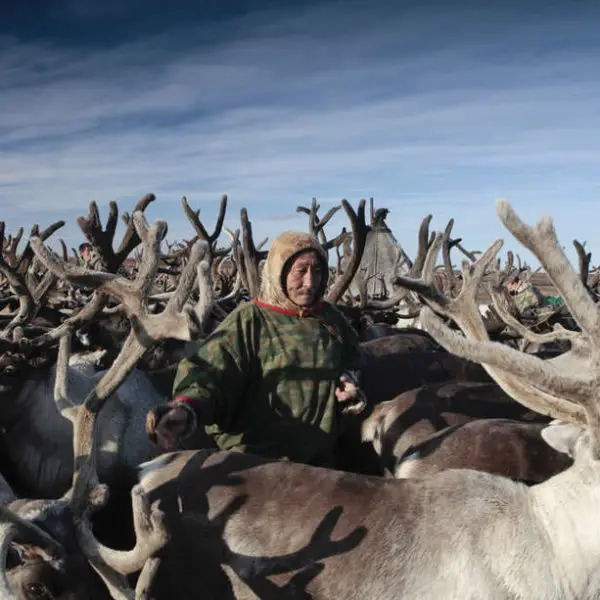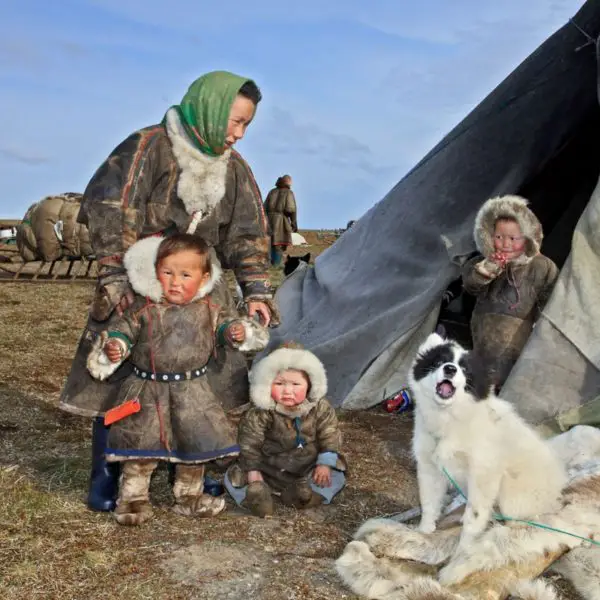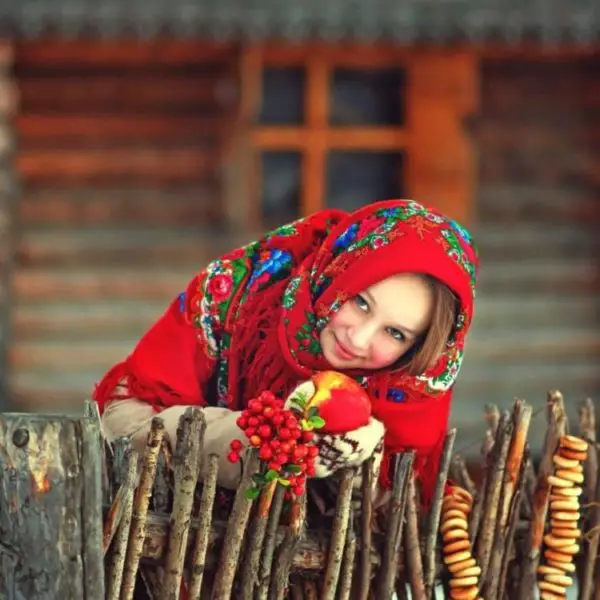Yamal Travel Guide - the Land of Nomadic Nenets
As the world gets smaller, there’s a desire to go further – and there are just a few places as enchantingly far away as Yamal. One of the last refuges of Russia’s nomadic reindeer herders, it is so far north that most of it is located beyond the Arctic Circle.
‘Yamal’ means ‘edge of the world’ in the language of the indigenous Nenets people. Here, the Nenets carve out a unique way of life, seemingly at the limits of human tolerance.
Table of Contents
Why visit Yamal
The Nenets – the world’s last nomadic reindeer herders
Centuries ago, hundreds of nomadic tribes roamed vast areas of the planet, but today, nomadic culture is rapidly dying out. Because the local nomads – Nenets (also known as Samoyed) have remained isolated from the modern world in one of the most inhospitable environments on earth, they remain among the last ethnic groups to still practice a completely nomadic way of life.
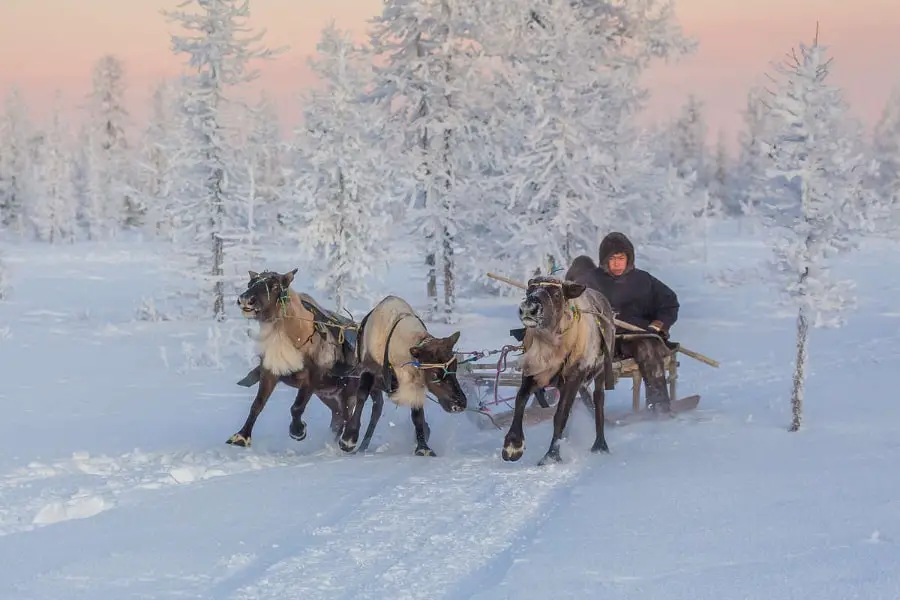
With a population of over 41,000, the Nenets are one of the largest indigenous groups in Northern Siberia, with the majority living in Yamal. For most of their existence, all the Nenets practiced a nomadic way of life. By herding reindeer and migrating twice a year to warmer pastures within their territory, the Nenets adapted to survive the harsh conditions and freezing temperatures above the Arctic Circle. The reindeer-herding Nenets are famed for having the longest migration routes on earth, relying entirely on wooden sledges for transport over the heavy snow and frozen rivers of the Arctic.
Nenets religion and beliefs
The traditional religious conceptions and customs of the Nenets fall within the general definition of Siberian shamanism. The shamans, of whom there were several categories, were the principal mediators between humans and spirits. The latter used to be represented by anthropomorphic wooden idols, of which great numbers were assembled in the sacred places of the Nenets.
As the Russians moved into Siberia and other remote parts of Russia, indigenous people were forced off their land and they began encroaching on Nenet land. During the 1930s, Nenet spiritual leaders and shamans were exiled. After the Russian Revolution, the Nenets culture suffered due to the Soviet collectivization policy. The government of the Soviet Union tried to force the nomadic Samoyeds to settle down permanently. They were forced to settle in villages and their children were educated in state boarding schools, which resulted in the erosion of their cultural identity. Many, especially in Yamal lost their mother tongue and became assimilated.
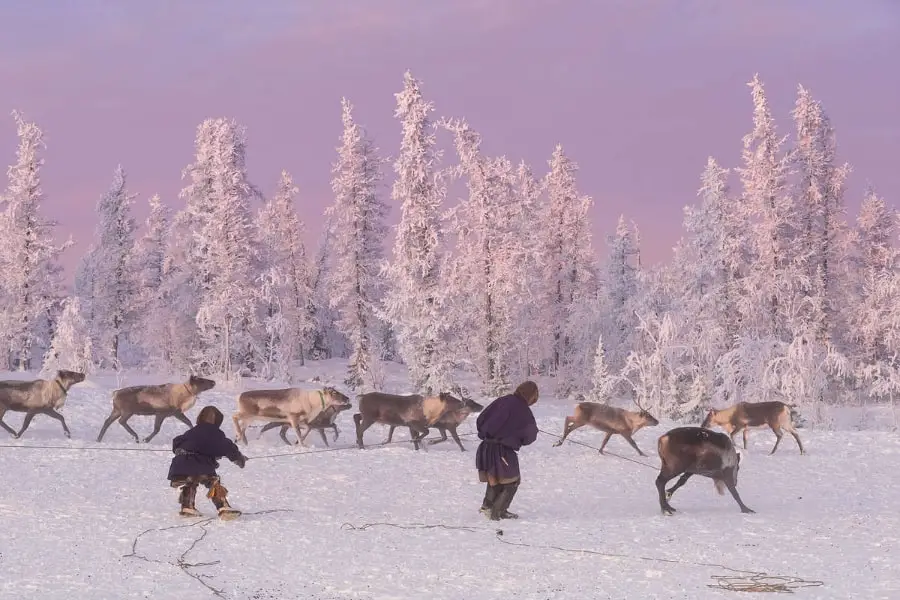
During the last few centuries the traditional religious conceptions came to be mixed with elements of Christian origin, and figures from the Orthodox pantheon, notably Nikolai Chudotvorets, or Mikulay in Nenets, were adopted as patrons. Officially, Christianity reached only the western Tundra Nenets, whereas some of the eastern groups preserved shamanism until the Stalin period. Today the shamanist worldview seems to have largely vanished in favor of the official materialistic ideology.
The Nenets are reluctant to talk to outsiders about their spiritual beliefs. They are not afraid of mixing with the modern world. They use radios, TVs, and reject what they don’t feel the need. Nenet children are still required to attend Russian-language schools.
Nenets culture
For the Nenets, the reindeer, one of the few animal species with the ability to survive the sometimes brutal, blizzard-blown conditions of far northern Siberia, is everything. Reindeers are used for transport, clothing, building, milk, meat, blood and fat. As one of the few food sources available, the Nenets rely on reindeer meat for subsistence throughout the year. Freshly butchered deer are usually eaten raw, and the Nenets are also partial to drinking the blood – although for guests, partaking in this practice is optional!
The Nenets wear clothing made of reindeer fur, sewn together using reindeer sinew, and live in conical tents made of reindeer bone and hides, known as chums.
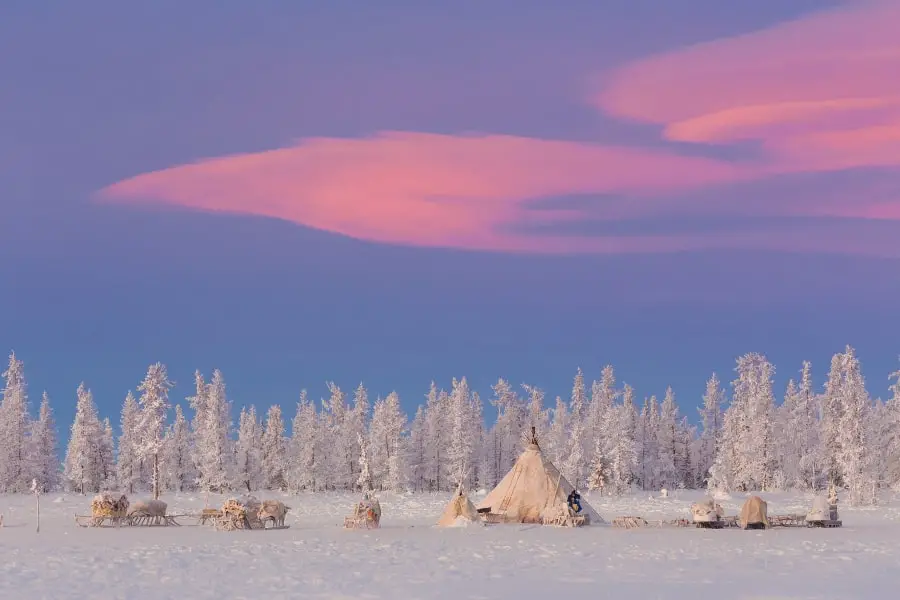
The Nenets diet contains mainly of bread and reindeer meat. When freshly slaughtered, reindeer are typically served raw and still warm (including the fresh blood, a nutritious drink). Otherwise, the meat is frozen for year-round safekeeping. The Nenets supplement their diet with other protein sources when available such as white salmon and other fish. During summer months, they also gather cranberries or other forest fruit for making tea.
While the Nenets struggle to keep their culture alive against the mounting pressure of climate change and industrialisation, outside interest in culturally respectful, eco-tourism provides a glimmer of hope that the last of the world’s nomadic reindeer herders can hold on to their traditional way of life into the next few generations.
“These are indeed people who live in a totally different dimension.” – Russian archeologist Andrei Golovnev told National Geographic. “They do not want to be the same as everyone else. They just want to be who they are.
Homestay with Nenets
There’s really only one reason foreign tourists brave the lengthy travel times and intimidating climactic conditions that await them in Yamal: they have come to observe and participate in a way of life that has, against the odds, remained relatively unchanged for around 2,000 years.
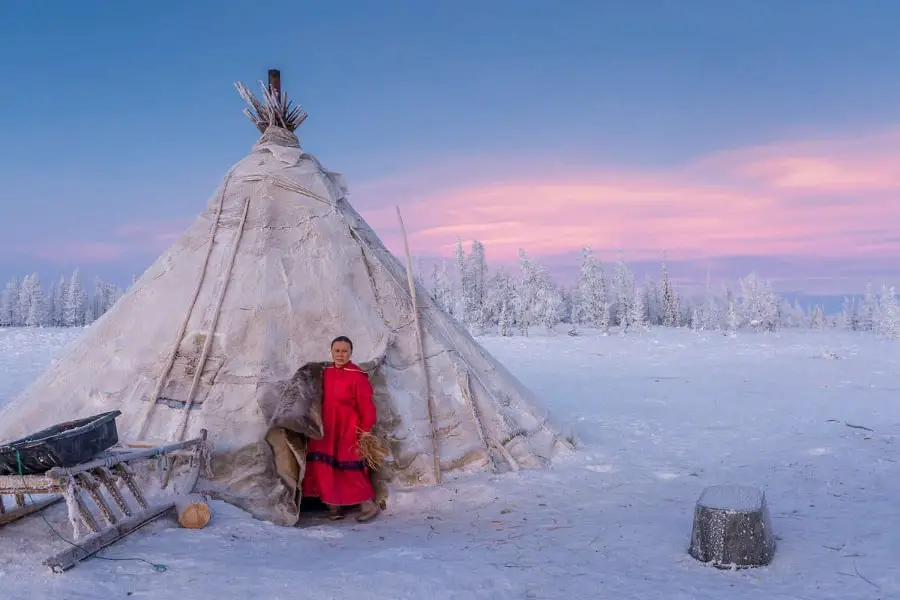
With no hotels, no stores, no modern communication and very few places to find shelter from the elements, the only way to visit Yamal’s Arctic region and Polar Ural Mountains is to stay with the Nenets in their nomad camps. The whole idea behind a homestay with the Nenets is to immerse yourself in their daily lives, culture and customs. Generally, you’ll be sharing a chum with a host family, giving you the chance to bond with your hosts and enjoy more opportunities to exchange experiences and ideas. During your stay, the locals will go about their daily lives, but will invite visitors to watch or lend a helping hand, as long as you’re physically able and comfortable with the task at hand. Who knows, you might find you have a special talent for lassoing reindeer, chum building or sledge assembly!
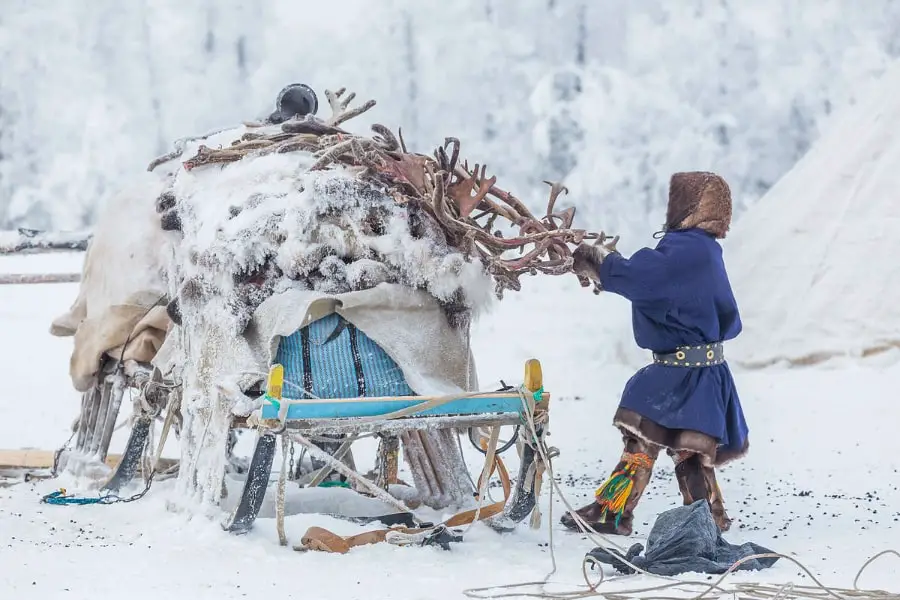
You’ll also have the chance to involve yourself in the preparations for making new campsites, sledding into the forest to cut trees for firewood, collecting ice or snow for water, sewing fur clothing and other activities essential for survival, relaxation and social bonding within the community. While the Nenets are extremely hard workers, many are often eager to socialise with their temporary guests, and it’s common for Nenets to sit together and converse around the open fire after dinner.
Experience the reindeer migration with the Nenets
The few visitors who do make it to the isolated Yamal, generally come to experience and participate in the Nenets annual reindeer migration events. The migration to and from Yamal’s summer pastures is carried out each year by the indigenous Nenets, traveling across ancient migration routes in the tundra as they have for thousands of years.
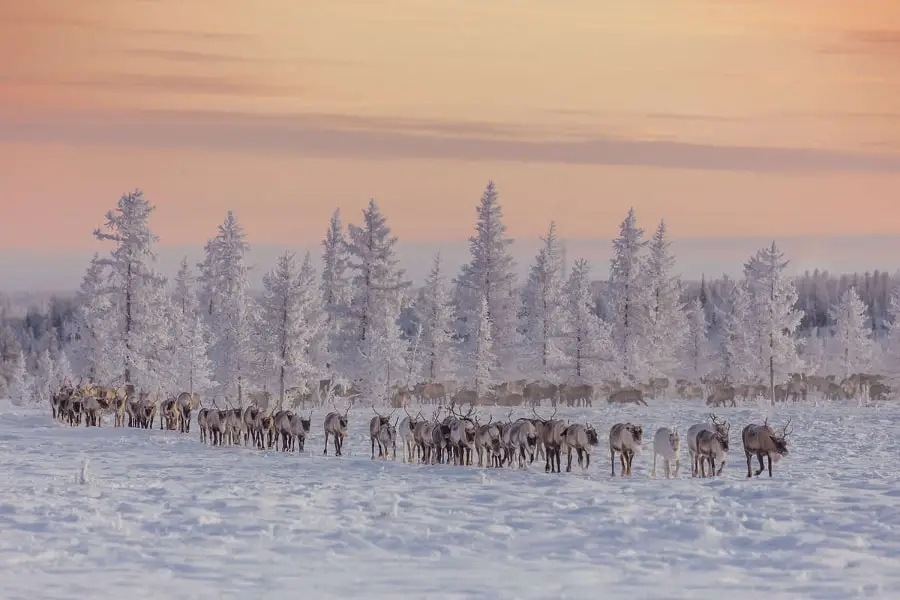
Accompanied by herds up to 10,000 strong, twice a year, the Nenets complete the world’s longest nomadic migration. Before winter temperatures in the Yamal Peninsula can plummet to an unfathomable -50°C, the Nenets must move their reindeer further south to the moss on lichen pastures in the southern taiga.
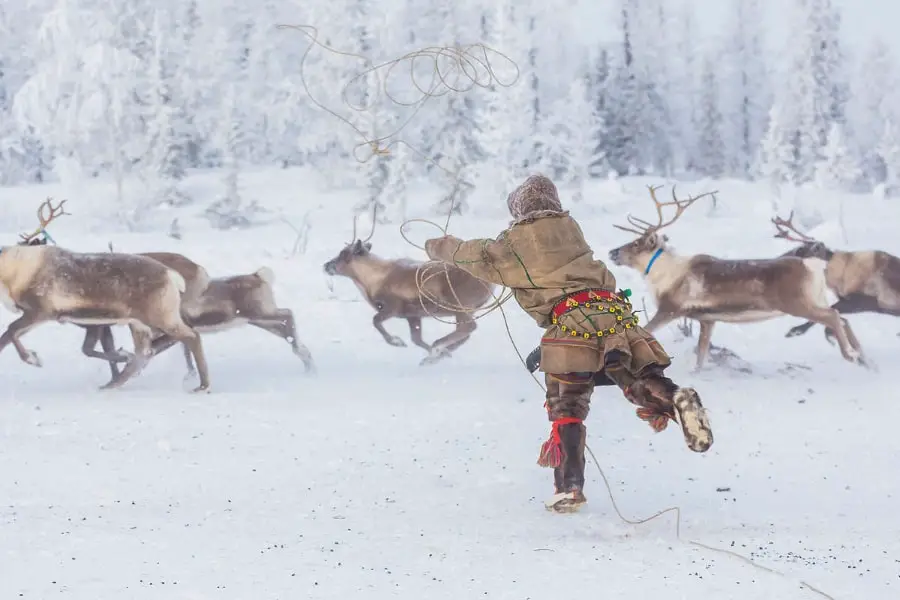
Every Spring, the Nenets then shift their enormous herds north to summer grazing grounds in the Arctic Circle. This massive journey (which even seasoned travel photographers and adventure travellers often describe as one of the most spectacular experiences of their lives), usually starts in mid-March through to mid-April. During this period, temperatures are still freezing, as part of the journey for some groups of Nenets involves crossing a wide expanse of the frozen Ob River, or moving to the Polar Mural Mountains.
The Spring reindeer migration sees thousands of reindeer and their herders travelling anywhere between 250km to 1,000km along the Yamal Peninsula to the Kara Sea, covering around 25km per day.
The Autumn migration starts near the end of September and runs through to mid-October. During this time, it’s possible to see vivid patches of greenery and wildflowers as the seasons change – these months are slightly warmer than the Spring migration. Depending on the weather, the nomad camps can be shifted almost every day, or a couple of days per week. In favourable conditions, the Nenets may spend several days or weeks in one place, repairing sledges and chum coverings before moving on.
Migration involves the chums being taken down and packed on to hand-made, wooden, reindeer-drawn sledges, along with all their possessions. The reindeer herd are then collected and harnessed to the sledges. The entire camp is then transferred by sledge, moving anywhere between 3 to 60km to a new spot for re-establishing the chums. A single move can take between 12 and 24 hours.
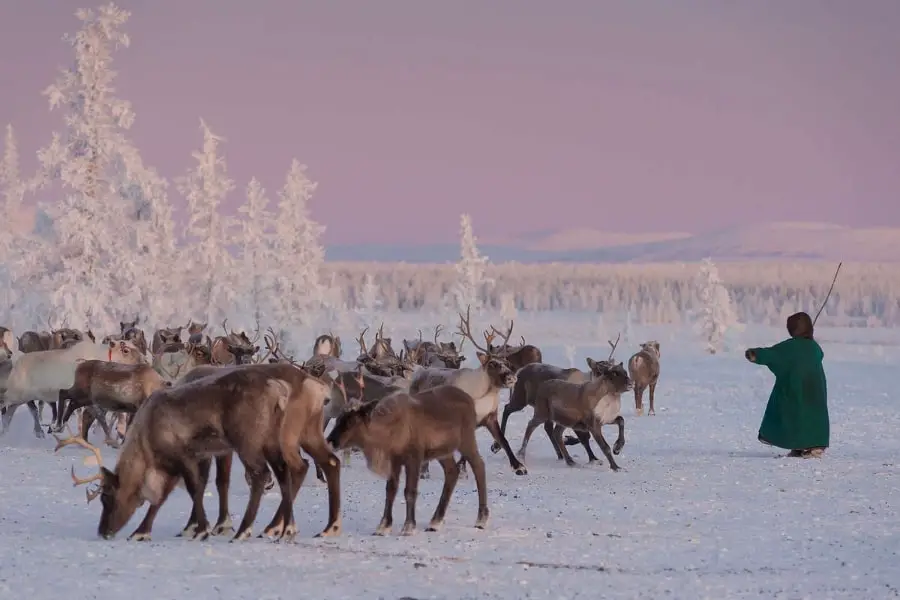
If you join a migration tour, keep in mind that during the migration, you’ll be outside the entire time, with no protection from the elements other than your clothing.
Joining a reindeer migration is about as far from a mainstream holiday as you can get, but for inquisitive, intrepid and physically fit adventure travellers, the chance to experience the nomadic lives of the Siberian people is an unforgettable, once in a lifetime event.
See below some common Reindeer migration routes:
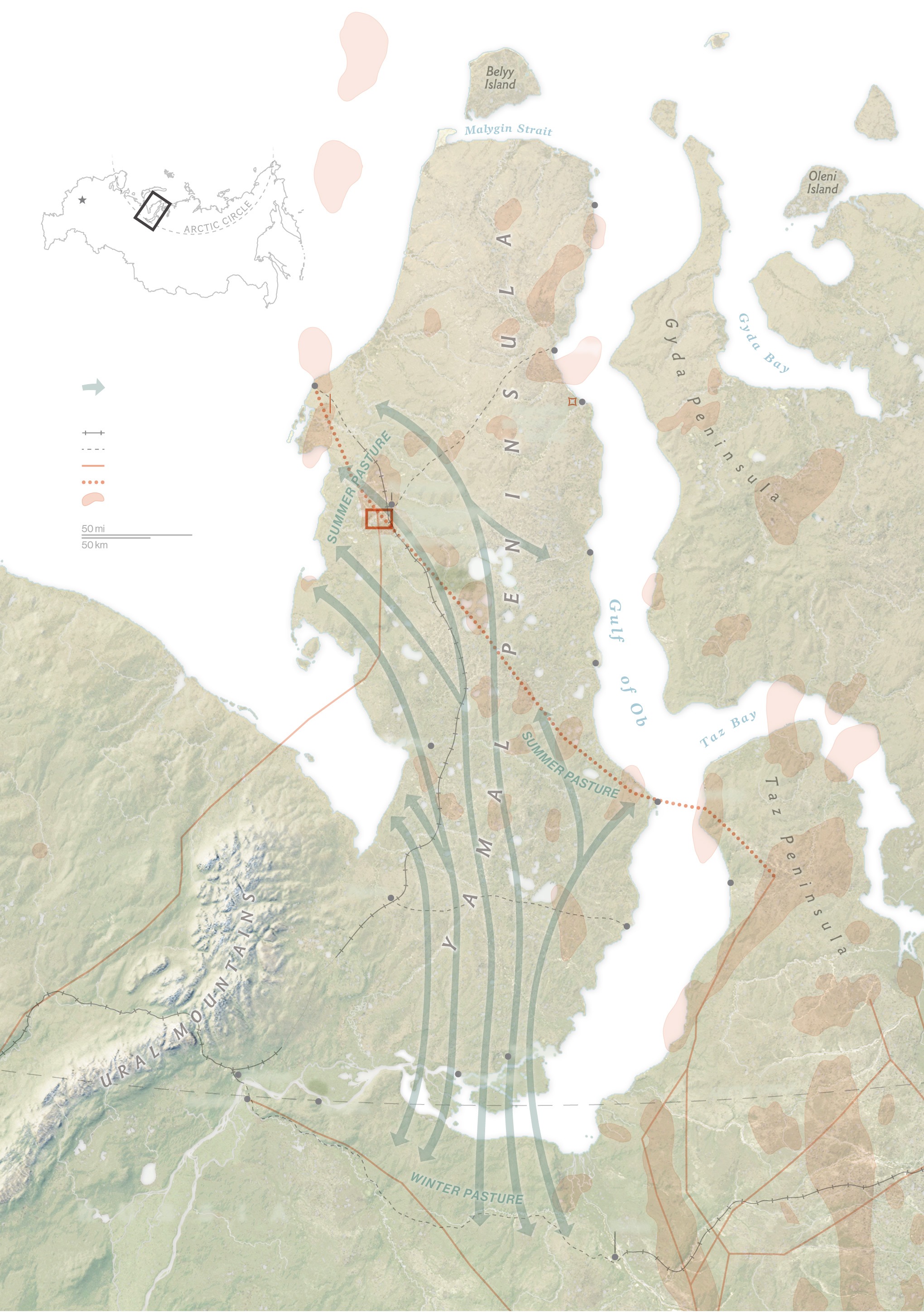
The Reindeer Herders Festival
If you don’t wish to join the Nenets on their annual migration trips, we’d have to say the best time of the year to visit Yamal is during the end of March through to early April. This is the time when the nomadic Nenets from across the Yamal Peninsula travel in their family groups to celebrate the one-day Reindeer Herder’s Festival. Held annually in different cities and villages of Yamal, the festival usually takes place on the last Saturday of March (in Salekhard) and the 1st Saturday of April (in Aksarka village).
For the Nenets people, a festival day is a major event. Herders from all over the tundra bring their families to town to sell their crafts and other wares, meet with friends and compete in rough-and-tumble contents of physical skill. Events held on the day include reindeer wrangling, sledge races, axe throwing and tug-of-war. Wandering the festival grounds, you’ll be able to pop inside the specially erected chums and taste unique Arctic delicacies such as stroganina (cloudberry jam). The Nenets women cut striking figures against the pure white snow, dressed in their brightly coloured traditional outfits.
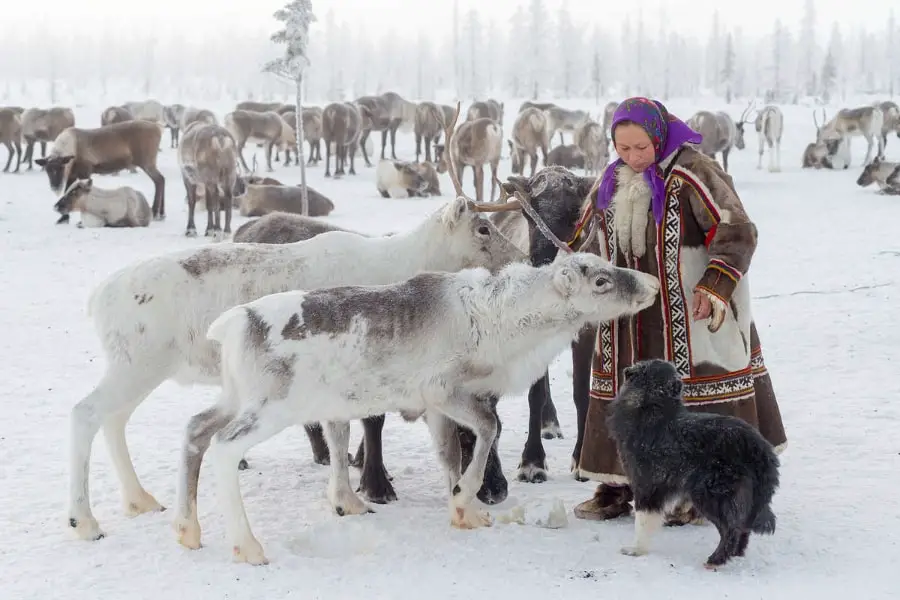
The Reindeer Herder’s Festival has also become an event in which the Nenets are able to share with the world a fascinating slice of their unique culture. On a Yamal tour during the festival season, you’ll also have the chance to stay with a Nenets family far from the city, giving you an amazing opportunity to fully immerse yourself in the nomadic way of life. With a bit of luck, at this time of year, you might even get to witness the Northern Lights streaking across the pristine polar sky.
An opportunity to experience the Northern Lights in Yamal
With most of Yamal sitting above the Arctic Circle, the region is one of the best destinations in Russia to observe the fantastic spectacle of the Aurora Borealis or Northern Lights.
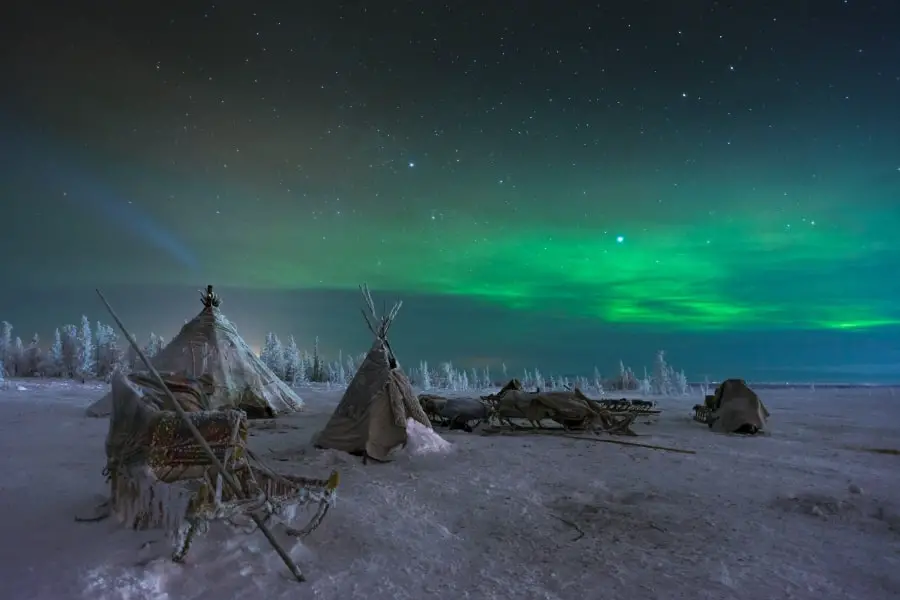
The Aurora Borealis is usually observed during winter, most commonly between September and May, and best of all in January and February. The prime season for catching this spectacular celestial light show is the New Moon in February, when the Aurora is commonly sighted for around two weeks straight.
February, deep winter in Yamal, is one of the few months the Nenets don’t migrate. On the other hand, it can be a great time to experience a more relaxed homestay with the Nenets, as long as you can withstand the extreme cold!
When to visit Yamal
So basically, the best time to visit Yamal is spring, starting from the end of March till May. During this time, while you still see the Russian Arctic in her winter beauty and the Nenets will be wearing their traditional winter clothes, the weather is not that cold and the daylight is much longer than in winter. Also, the Reindeer Herders Festival takes place at the end of March and the migration starts in mid-April.
With almost the entirety of its territory above the Arctic Circle, Yamal is completely ice-bound for seven to nine months of the year. In deepest winter, darkness shrouds the peninsula, snow piles up metres high and on the very coldest days see the temperature plummet to below – 50°C. The coldest months are January and February when the average temperature lies between -24°C and -28°C. For much of the short summer season, the sun never dips below the horizon, lighting up the vast tundra and muskeg landscape 24 hours a day. The warmest months of the year are July and August, with average temperatures around 5°C on the Arctic Ocean coast of the Kara Sea, up to 10°C in the Yenisei Gulf.
Temps and daylight hours in Yamal
| Month | Daylight | Average Temp |
| Jan | 4-6h | -35 C |
| Feb | 6-8h | -25C |
| Mar | 10-13h | -15C |
| Apr | 13-15h | 0C |
| May | 17-22h | +5C |
| Jun | 24h | +10C |
| Jul | 19-24h | +15C |
| Aug | 15-17h | +12C |
| Sep | 12-14h | +5C |
| Oct | 9-11h | 0C |
| Nov | 6-8h | -15C |
| Dec | 4-6h | -30C |
Getting there and around
Nearly all tour groups and independent travellers begin their journey deeper into the Yamal region from Salekhard, the capital of the Yamalo-Nenets Autonomous Region.
Salekhard is the only city in the world, located directly on the Arctic Circle. As you might imagine, residents aren’t exactly your everyday small townsfolk, and the city comes across as simultaneously tough and quirky. Russian settlers founded the town on the banks of the Ob River in 1595. It became a popular place for exiling dissidents during the Tsarists and Soviet periods. These days, Salekhard is a thriving, surprisingly prosperous town. In fact, it’s one of the most affluent in the entire Arctic region, thanks to the discovery of nearby oil and gas reserves. For visitors, Salekhard is an interesting place to spend a day or so.
Attractions include:
- Shemanovskiy Yamal-Nenets District Museum and Exhibition Complex. Compact well-organised and surprisingly engaging, this museum focuses on the anthropological and natural history of Yamal and makes a great primer before diving deeper into the Nenets culture. The most interesting exhibits relate to the relatively recent local discovery of woolly mammoth remains. The highlight is “Baby Lyuba” the mummified body of a mammoth calf which is almost completely intact, despite being approximately 42,000 years old.
- Odorsky Burg (Master’s Town).A short walk from the city centre is this small historical replica village. The collection of wooden farmhouses and religious buildings represent how the town might have looked after it was settled by the Cossacks in the 16th century.
- Polar Circle Monument. Roughly half of Salekhard lies north of the Arctic Circle. A shiny modern monument marks the Polar Circle’s exact latitudinal line. Worth stopping by for a ‘geography selfie’.
- Mammoth Monument. A large sculpture of a woolly mammoth stands on the shores of the Ob, close to where several mammoth finds have been uncovered. There’s not much else to look at but getting there requires crossing an impressive frozen bridge over the icy Ob River.
By air from Moscow or St Petersburg
By far the easiest way to reach Yamal is by air. Yamal Airlines flies once per day between Moscow, St Petersburg and Salekhard, and the flight time is just under three hours and costs about US $150 one way.
By train from Moscow
If you are planning to arrive to Yamal y train, your final stop will be Labytnangi, which be reached via two to two and a half-day train trip from Moscow. From here, you will need to get to Salekhard by car, over the frozen ice of the Ob River. In the summer, the two towns are connected by a ferry route.
Note that some parts of the Yamalo-Nenets Autonomous Region may require a special Border Zone permit for outsiders to be granted access. Your tour agency will advise you in advance if you need to apply for this permit for your particular trip. If your tour requires this permit, it must be arranged 2 months in advance.
Eating and sleeping in Yamal
Food and accommodation in Salekhard
As the prosperous polar city of Salekhard slowly begins to receive more outside visitors, the options for accommodation in town are slowly on the increase. Don’t come to Salekhard expecting luxury – however, there is a reasonable choice of two and three-star tourist guesthouses and business hotels located in the centre of town. Salekhard has quite a decent selection of restaurants and cafes serving Russian, international and traditional Yamal cuisine. Breakfasts are typically included with your hotel stay, while meals run at approximately 1,300 RUB (US $20) for lunch and about 2,000 RUB (US $30) for dinner.
Beyond Salekhard
Once you move beyond Salekhard, deeper into the tundra and the territory of the nomadic Nenets, you’ll be sleeping in the reindeer camps inside the chums, generally sharing a chum with a host family. The chums are cosily warm even during the harshest winters, heated by an open stove and the heat kept in by a covering of thick reindeer hide.
On some group tours, a private chum for the group may be a possibility for those not wishing to stay with a Nenets family. The Nenets however, are sociable and curious and generally happy to talk to visitors and exchange experiences and ideas after a long day maintaining the camp.
Meals and eating customs in the Nenets camp
Once at camp, visitors usually subsist on the typical nomadic diet, mostly made up of preserved meat, fish, bread, jam, condensed milk, biscuits and tea. Soup, rice, pasta, noodles and other packaged foods are usually also provided or can be purchased beforehand in Salekhard.
While Nenets mostly eat reindeer meat raw, you certainly won’t be expected to do the same. As long as you show respect for their customs, you can choose whether to partake or not. It should be remembered that this is intended to be a culturally immersive experience, with everything that entails.
Tour packages in Yamal Peninsula
Due to the extreme remoteness of the Yamal Peninsula, and the logistical and communication challenges involved in organising a homestay with the Nenets, we strongly advise that visitors travel to Yamal on an organised tour. Your tour organisers will arrange your stay with one of the Nenets groups open to receiving visitors. They should also arm you with all the information you’ll need to prepare for a trip to one of the coldest and least-visited populated regions on the planet.
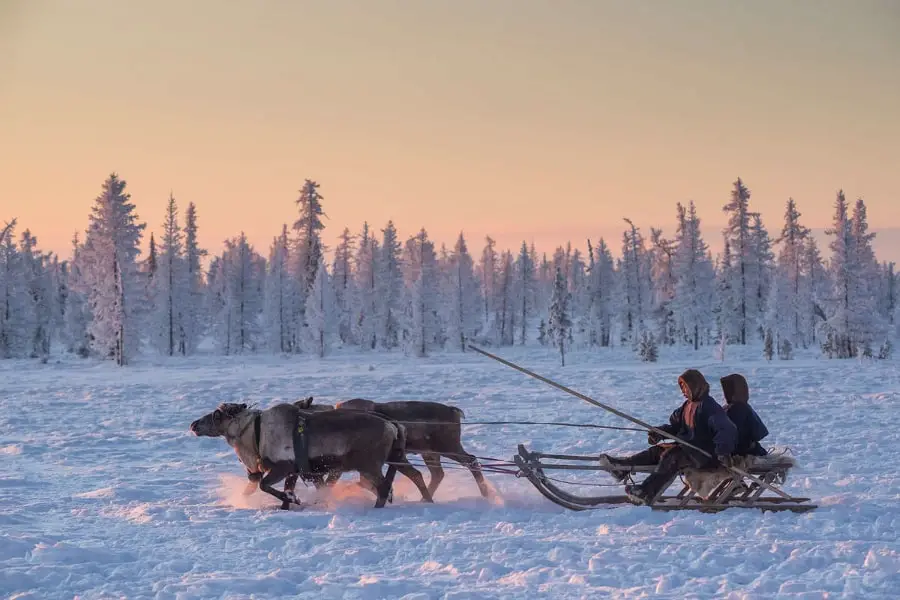
56th Parallel offers a number of culturally immersive tours to the Yamal Peninsula during the key periods of the spring and autumn reindeer migrations, and the annual Reindeer Herder’s Festival. We also offer a winter photography tour (outside the migration season) offering a homestay with the Nenets and exceptional conditions for hunting the Northern Lights over the tundra over the star-strewn Arctic winter sky.
All photos used in the article belongs to Russian photographers ©Kirill Uyutnov and Katerina Vasyagina.
Related posts
Related Tours
If you have any urgent questions or enquiries, please give us a call +61 412 587 785
